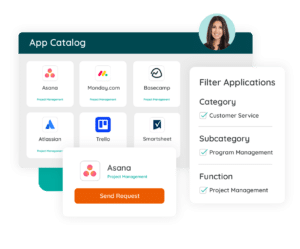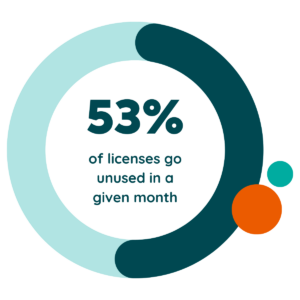Table of Contents
With the threat of recession looming, budget cuts and layoffs continue to sweep the nation. But even with smaller teams and budgets, executives and leaders still expect their companies to meet or exceed the same goals based on the previous year’s performance.
While this forces businesses to prioritize how and where they invest for the year, it also creates opportunity to get creative and accomplish more with less.
When the budget gets lean — but the expectations remain high — follow these tips for driving innovation.
Implement Creative Problem-Solving Techniques
Creativity often sparks when our backs are against the wall. For example, consider when the COVID-19 pandemic hit in 2020. A McKinsey & Company survey in April 2020 found two-thirds of executives responded it would be the biggest challenge in their careers, yet 75% of those surveyed noted the changes forced upon them would generate big growth opportunities.
Since that time, we’ve seen industries transform. The use of telehealth took off, companies across industries adopted hybrid or virtual work arrangements, QR codes made a surprising comeback, and SaaS adoption skyrocketed. What do these things have in common? They were all driving innovation out of necessity.
Now, it’s time to lean into creative problem-solving strategies, including:
Reverse brainstorming: This sounds counterintuitive, but instead of brainstorming how to solve a problem, consider how to make the situation worse. Once you have a list of ways to make the situation worse, reverse them, and work through how to prevent those issues. Doing so requires ingenuity, and may help your team think of possibilities to improve or secure the business that they never considered before.
Eisenhower principle: To effectively prioritize, apply the Eisenhower principle to your current list of issues. This means imagine if each situation were 10x worse. SUCCESS Magazine provides the example of an employee being 10 minutes late and a company computer going missing. If 10 computers went missing, you’d address the issue immediately. That takes precedence over one person being late.
Six step problem-solving model: This model, developed by Edgar Schein, encourages you to approach your issues methodically with these steps:
- Define the problem.
- Define the root cause or causes of the problem.
- Develop possible solutions.
- Choose the best-seeming solution from the list.
- Implement the solution.
- Evaluate the outcome of the solution.
Empower Employee Productivity with an App Catalog
Employees innovate and produce on a higher level when they have access to the proper tools. And the whole company leveraging the same set of tools enhances collaboration and supercharges innovation and productivity.
Without workers knowing which apps are available to them, they might:
- Download their own apps, which don’t integrate with existing software or provide the best solution
- Complete their job using manual processes when software could automate several tasks and save time
- Submit an IT ticket to download a specific app, causing more work for your IT department and putting their project to a halt while they wait on a response
 Avoid these scenarios by creating an App Catalog that includes a list of pre-vetted and available software for employees to download and use.
Avoid these scenarios by creating an App Catalog that includes a list of pre-vetted and available software for employees to download and use.
Zylo’s App catalog helps:
- Drive awareness of business tools: Users can easily find out what software is available. If a user searches for an app not available in the catalog, one with similar functionality will be offered to them.
- Fast track employee onboarding: A single source for all the software used in the business gives employees the tools they need to hit the ground running on day one.
- Give users clear lines of communication: Within the App Catalog, employees can find info about an application they may need, including its categorization, designated function, whom to contact with questions about the app or to request access, and any other relevant details.
Unlock Money to Reinvest in the Business
Look for opportunities for savings throughout the organization, then reinvest in your business. Considering the following data, SaaS applications provide a great starting point:
 Companies will overspend on SaaS by 25%, according to Gartner.
Companies will overspend on SaaS by 25%, according to Gartner.- 53% of all SaaS licenses go unused in a 30-day period, and the average organization wastes $18 million on unused SaaS licenses.
- More than 51% of all SaaS applications found by Zylo’s Discovery Engine are not categorized as software purchases.
Without visibility into your SaaS stack, the opportunities to save money remain hidden. Investing in a SaaS Management platform like Zylo gives you a comprehensive picture of all your SaaS applications, spend, and usage. In addition, the software surfaces insights and recommendations for cost savings, like consolidating cross-functional apps, eliminating duplicate apps, or moving several individual licenses into an enterprise agreement.
Brad Pollard, former CIO for Tenable, utilized usage information within Zylo to discover his company’s phone data, and found that only his customer service team was making calls.
“So we looked at what it would be to move the voiceover IP to Zoom phone, and it ended up being a fraction of the cost,” he said in our podcast, SaaSMe Unfiltered. “We ended up staying flat on budget, not losing any functionality and then having money to fund innovation.”
For a deeper dive into unlocking savings and driving innovation, check out our blog on how a SaaS Management platform helps you reinvest in your business.


 Companies will overspend on SaaS by 25%, according to Gartner.
Companies will overspend on SaaS by 25%, according to Gartner.